EUROPE AND ASIA IN THE ERA A.D.
George Speaight, in his book The History of the English Puppet Theatre, mentions that: “In the sixth century the Bishop of Alexandria [of the Byzantine Empire] referred to little wooden figures that were shown at weddings, and were moved by some kind of remote control in the actions of dancing.” It is known that medieval churches used automata moved by clockwork mechanisms, to attract the congregation. Allardyce Nicoll in Masks Mimes and Miracles gives us an early history of puppets in Europe:
These, called by various names of which bastaxi, joueurs des basteaux, and juers dels bavastelz, were the commonest, carried round their small wooden marionettes and gave shows with them. The art of the puppets had never been lost since the time when Xenophon introduced it at a Greek banquet. Among the entertainments condemned by the Fathers of the Church the neurospasta often figured; Tertullian condemned them under another name, sigillarium. In the Eastern Empire they are found flourishing during the sixth, eighth and twelfth centuries, while in the West there is ample record of their popularity….In the thirteenth century the Provençal roman called Flamenca mentions “the play of puppets” (lo juec dels banastelz [should be bavastelz?]…in 1317, the Council of Tarragona condemns the bastaxi; while in the fourteenth century and later references to them are common.
So we see that puppetry continued in a limited form down to our era. After the collapse of the Roman Empire with its strong theatrical traditions, and with the subsequent rise of Christianity in the early centuries AD, all sorts of entertainments were supressed by the Church Fathers, or dissipated of themselves. But not for long did the puppets remain a rare form of entertainment.
The earliest drawing we have of puppets in Europe (for that matter, the first drawing of any sort of puppet) is in the Hortus Deliciarum (“The Garden of Delights”) by the Harrad von Landsberg, in Strasbourg, dated AD 1170. (The original was destroyed in a fire in 1870, but tracings had been made prior to this catastrophe.) This is an unusual picture and worth examining a little more closely. Most puppet histories show only part of the whole picture, the two children(?) holding the strings of the little knights. I here reproduce the entire illustration, showing King Solomon on his throne observing the “show.”
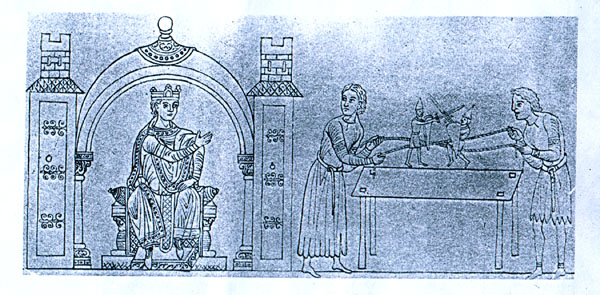
But it is not so simple as that. If one refers to the text written on the document which reads: Ludus monstrorum, and, In ludo monstrorum designatur vanitas vanitatum, and which roughly translated means: “Unnatural play” (often given as “The Game of Marionettes”), then, “In playing unnatural things indicates vanity of vanities,” we see that this picture actually represents not so much a puppet show as a demonstration of a pastime that is unworthy of a true Christian. And King Solomon is the one pronouncing judgment on such frivolities. The King then is not actually the audience of a puppet show, but rather a Christ-like figure looking down from his throne at his subjects passing their time in evil, unnatural play, and denouncing them. This picture is often thought to depict only a children’s toy or game.
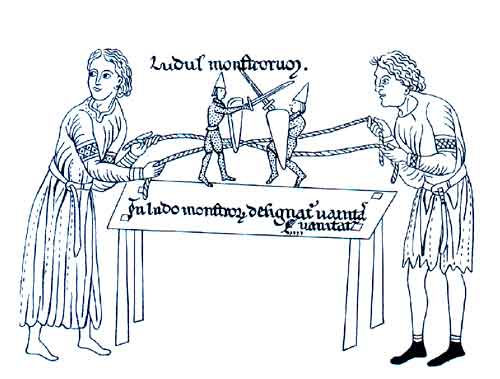
The date of this document, 1170, is during the time that ordinary folk from all over Europe traveled East to Islamic countries to drive out the infidel from the Holy Lands. They traveled to Egypt, Turkey, and Arabia and some returned home bringing along new ideas and customs from the exotic East.
…Europe was not impervious to Islamic influence. In these struggles she imported and invented new habits and institutions. Wherever contact occurred with Islam, whether in the crusading lands, Sicily or Spain, western Europeans found things to admire. Sometimes they took up luxuries not to be found at home, silk clothes, the use of perfumes and new dishes [Roberts].
Before this time, around AD 711, the Moslems had conquered almost all of Spain and soon occupied territories in Portugal and France, plus the Italian islands of Sicily and Sardinia. They ruled these territories for over 500 years.
There are no documents showing when and where Oriental puppets came to Europe, but the example of the history of the game of chess may serve as perhaps the method and path of transference.
There exists a Persian manuscript from the 14th century which describes how an ambassador from India brought chess to the Persian court (see picture). “From India, chess made its way to Persia and was thence taken to Europe by the Arab conquerors of medieval Spain” [Grunfeld].

I quote at length from Chess: a Celebration of 2000 Years:
Europe has the Arabian world to thank for passing on its rich cultural heritage of classical antiquity and its exemplary wealth of music and poetry. European civilization in the Middle Ages was greatly enriched by cultural exchange with the Arabian Emirates in Spain and the passing on of knowledge via Sicily (Emperor Frederick II of Hohenstaufen). Chess was only one of the many areas in which the Arabian influence made itself felt.
…At the beginning of the 8th century, the Arab world extended as far as the Iberian Peninsula, Sicily and Sardinia. Europe was greatly enriched by the contact with Arabian culture and civilization. The Arab world was far ahead of the Occident in adopting material goods, science and technical achievements of the Mediterranean countries, Rome and the Byzantine…The relationship between the Occident and the Orient was not only characterized by battles and atrocities between Moslems and Christians; there were also cultural exchanges between them in Spain and Sicily, which is how chess made its way into Europe. This can be confirmed by the oldest written references dated 1008 and 1058. Between 1008 and 1010, Count Armengaud of Urgal [Spain] wrote his last will and testament stipulating that on his death his priceless rock crystal chess pieces should be given to the Cloister Saint-Gilles-du-Gard near Times [France]. The Count’s sister-in-law from Barcelona, Ermesind, also willed a chess set to the same Cloister. The first Western European book dedicated to chess and its strategy was published in Spain in 1283. Titled The Book of Chess, Dice and Board Games, it is also known as the Alfonso Manuscript. King Alfonso X, the Wise, probably only wrote the forward, but the document has been associated with his name ever since….By the 11th century, chess was generally known throughout Europe. There were several probable routes into Europe: chess could have spread to the north from Sicily and Southern Italy, where Arabian influence was still very strong; or it could have pushed its way into Central Europe via Asia Minor, the Balkans or the Byzantine (East Roman) Empire. It is also possible that it reached Central Europe via the trade routes from Central Asia through the southern steppes of early Russia. Chess figures found in Samarkand and Fergana of the 7th and 8th centuries can be definitely be traced back to Persia to a very early period of the Persian game. From here they spread further. By 1000 A. D., chess had probably made its way into the region of ancient Kiev Rus, the oldest of the Russian states, which lay on the regularly used Viking trade routes. Not only did the Vikings carry Arabian coins and statues of Buddha back to their Scandinavian homeland, there is evidence that they also carried chess pieces. Similar wide-ranging trade routes ensured that, by the 11th and 12th centuries, chess had made its way as far as Iceland. An Icelandic saga of 1155 tells the story of the Danish king, Knut the Great, playing chess in 1027.
Arabian chess pieces were found in many areas of central Europe during the 11th and 12th centuries. They could well have originated in Southern Europe but it is just as likely that they were brought from The Far East by the Vikings.
In the Alfonso Manuscript is a miniature where “three Indian seers bring a chess game and a dice game to the Persian king who is portrayed here as a Christian ruler.” And around this time, in Persia, we hear of shadow theatre, for the famous Persian poet Omar Khayyam (c. 1050-1123) in his Rubiayat writes:
We are no other than a moving row
Of magic shadow-shapes that come and go
Round with Sun-illumined lantern held
In Midnight by the Master of the Show.
Metin And mentions that “Mediaeval Egyptian shadow puppets [were] discovered in Menzala by Professor Kahle early this century.” (See pictures.)
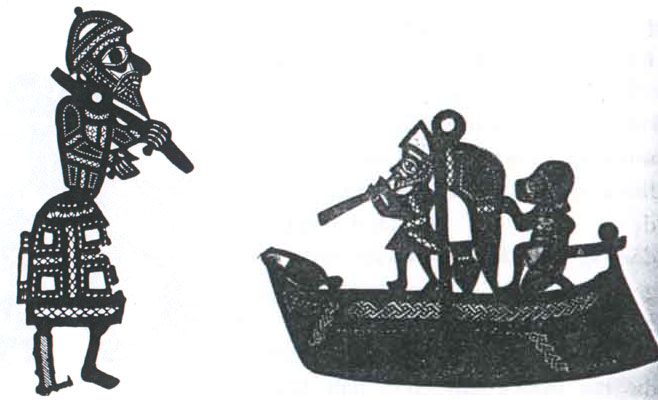
And, “before they came to know shadow theatre, in the 16th century, the Turks enjoyed a long-standing established puppet tradition.” A Chronological Outline of World Theatre indicates that in 1100 “Shadow puppets [were] popular in Egypt”, and, “Attar (d.1221), Persian poet, writes of puppet theatre in The Book of the Camel.”
It is notable that in just this same time frame, in 1211, we have the earliest reference to puppets in Spain from a poem by Girant de Calanso. “The juglar (jongleur), says de Calanso, should know how to present puppets (bavastels) and do conjuring tricks (e fey los castells assalhir)” [Mair].
Victor H. Mair, in his marvelous work Painting and Performance, gives evidence and the probable direction of the diffusion of picture narration out of India to China, Indonesia, Persia, the Middle East, Turkey, then Europe. The earliest evidence of picture narration in Europe was in Italy in the 10th century AD (these were called “exultet rolls”). So it is safe to say that along with picture narration likely went the Eastern forms of puppetry.
The next European illustrations in history showing puppets come down to us in the Flemish manuscript dated 1344 entitled Li Romans d’Alixandre, in the Bodleian Library. This possesses border decorations, two of which show glove puppets presented from puppet booths practically identical to those used centuries later by English Punch and Judy showmen (see pictures). But there is nothing in the text of the book to further explain the pictures, so we can infer descriptions of them would not have been required as they were by then a common entertainment.
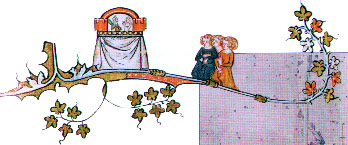
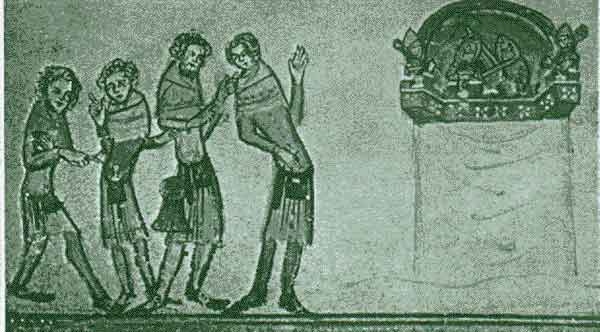
Puppet booths from the “Li Romans d’Alixandre” manuscript
In his book Dolls and Puppets, Max von Boehn, after discussing the idea that puppets developed independently in the different lands, says that “Philipp Leibrecht, however, rejects this highly illuminating conception, since he observes that not only the similarity of the persons represented, but also the likeness in the matter pertaining to the shows, testifies undoubtedly to an international connexion. This connexion must be granted, even if we are uncertain as to what way the transition from people to people came about.” World puppet forms are so varied and the records so sparse that a precise trajectory of their diffusion around the globe is impossible.
Gustave Schlegel gives an interesting genesis for the word poupée, which word may have been in turn the origin for the word “puppet”. I believe he derived this information from his review of the book Korean Games, mentioned above, whose author got it from an old chronicle, so the veracity of this history is doubtful, and Schlegel says so right after recounting it. I give it here for its great interest:
Dolls are of recent origin in Europe. In the beginning of the XVth century, during the reign of mad Charles VI of France, an Italian, named Pusello, came from Padua to France with 30 mules packed with boxes and hung with jingling bells. He had in these boxes wooden images of 96 empresses and other celebrated women of the old roman empire, carved after statues and coins. He showed them everywhere gaining a considerable fortune by their exposition. At last the counselors of the King called him to court in order to amuse His Majesty. When he came to the explanation of the statuette Poppea who, as is pretended, was killed by Nero by a kick in her belly, the king listened with greatest attention, and at last bought the statuette of Poppea for 50 parisian sols, about 300 francs of present currency. The king’s example was soon followed, and every nobleman bought such a little statue; and as the king’s one was that of Poppea, every one called his puppet Poppea, of which names the word Poppée, Pouppée and finally poupée are said to have been derived…it appears that such poupées or dolls came at that time in vogue as playthings for girls.
It has been asserted by some that Turkish shadow theatre was seen and talked of by returning Crusaders. Metin And says that a German traveler in the 16th century wrote of witnessing a Turkish shadow theatre performance. In fact, Germany seems to have the earliest mentions of European shadow theatre performances, according to Max von Boehn: “From the middle of the seventeenth century there is frequent mention of shadow-plays on the German stage – at Danzig in 1683, at Frankfort in 1692 – often along with the marionettes.” It is interesting that the Dutch East India Company was established in 1602 in Batavia (now Jakarta), and the Dutch are a very close neighbor to Germany. I suspect that the ombres chinoises in Europe were inspired rather by the Javanese than by the Chinese shadow theatre, since in Java the shadow figures are black and white silhouettes; the Chinese shadow plays today use transparent colored shadows, a technique never employed in Europe until after the 19th century.
There is a very interesting description in Ben Jonson’s play Tale of a Tub of what seems a kind of shadow show. This work is dated, in England, at 1633.
First, I have fixed in the earth a tub,
An old tub, like a salt-petre tub…
Now, sir, this Tub I will have capt with paper,
A fine oil’d lanthorn paper that we use…
Which in it doth contain the light to the business;
And shall with the very vapour of the candle
Drive all the motions of our matter about,
As we present them.
As explained in the play’s stage directions, this apparatus was hidden behind a curtain. The narrator appeared above the curtain, and gave his introduction, then, the curtain was drawn and the tub was revealed. There were five scenes shown, each called a “motion”. This term was used in England at that time to mean a puppet show. The single narrator and showman described the scenes each in turn. I would expect that the curtain was drawn before each change of scene, but Jonson does not say so.
In view of the fact that the British expanded their empire into India around this time (The East India Company was first established in 1612 at Surat) may account for the appearance of shadow theatre in the Commonwealth in the 17th century. It is well known that there was a great craze in France, England, and Germany for the ombres chinoises and cut out silhouettes in the 18th century.
The Englishman Samuel Pepys in his Diary of the late 1600’s describes puppet plays presented for adult entertainment. He mentions they were extremely popular with everyone, and the character Polichinelle had been recently brought from Italy. Pepys does not describe the shows except to call them “puppet shows,” so we can believe that since no descriptions were necessary, these were not new entertainments for the English. These shows must have been of marionettes, as marionettes were the most prevalent type of puppet at that time. From this period forward, the records and pictures depicting puppets increase.